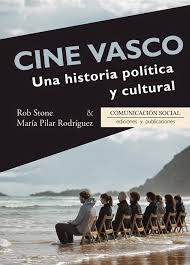
Whose Film is it Anyway?
This week at Mediático, regular contributor and contributing editor Rob Stone, co-author (with Maria Pilar Rodríguez) of Basque Cinema: A Cultural and Political History (I.B. Tauris 2015) and Cine Vasco: Una historia political y cultural considers the ramifications of the Spanish Film Academy’s choice of a Basque-Language film – Loreak (Flowers Jon Garaño & Jose Mari Goenaga, 2014) to represent Spain in the Best Foreign Language Film category at the 88th Academy Awards. See some of Prof. Stone’s other posts/video essays, here and here.
The announcement that a Basque Basque-Language film has been selected by the Spanish Film Academy to represent Spain in the Best Foreign Language Film category at the 88th Academy Awards is not so much a cause for innocuous pride as it is a grenade lobbed into weary definitions of national cinemas. Following the narrow majority won by Separatists in Catalonia in the recent regional parliamentary elections, which many have read as a vote for secession from Spain, this latest self-inflicted wound on the idea of a national Spanish anything is based not upon a partisan film about ETA or a völkisch pastoral epic or an ikurrina-waving war film but on a still, quiet, intimate picture about flowers and the way people use them to arrange their lives.
Loreak (Flowers, Jon Garaño & Jose Mari Goenaga, 2014) is Basque in its language, cast, setting and sentiment. Like the directing team’s previous feature, the delicate and deeply affecting 80 egunean (For 80 Days, 2010), what is explored within is emotional repression and the contrast of expressive release. Freedom to feel, in other words, is the point of both films, whose maturity, formalism and great subtlety unveil an intra-history of ordinary Basques. For Chris Perriam, 80 egunean ‘is a ‘powerful vignette [that] points starkly to the muting effect on emotional intelligence of conventional heterosexual partnerships gone stale’ (2013: 61). This emphasis on secret loves as the key to hidden lives is also crucial to Loreak, which looks at the tangled language of flowers left by lovers and mourners. As such, it is a fragile film to withstand the debate that will probably accompany its nomination, let alone the conflagration that may ignite should it win.
Is Loreak a Basque film and can a Basque film – especially a Basque-language one – also be Spanish? Can a high-profile film of indubitably Basque identity such as this be contained within the ideas and limitations of a Spanish national cinema? Or is the recognition due to Basque cinema liable to re-calibrate the history of Spanish cinema too, dressing the films directed by Víctor Erice in Basque colours, for example? Nominations such as these ultimately mean little, perhaps, and there is no guarantee that the American Film Academy will pay them much attention. At the time of writing, Loreak has no American distributor and foreign rights are still available from Film Factory Entertainment. Unless a major distributor such as Sony picks it up, it is unlikely to play beyond festivals. This recognition of the superior filmmaking talent of Garaño and Goenaga apart, however, there is cause for celebration, amusement and concern at this nomination. Such a knotted response is a symptom of the reconfiguration of purportedly ‘national’ cinemas that has been happening in the transnational film industry for which awards ceremonies serve as shop windows. Is Loreak too local to be national – too Basque to be Spanish – or does its regionality/nationality (delete if you dare) actually serve to override politicised geographical considerations and make it universal instead?
In a forthcoming jointly-authored article in the Bulletin of Hispanic Studies, María Pilar Rodríguez and I wondered about:
This combination of regionalism with universalism [as] a powerful means of identity and association with other cinemas of ‘small’ nations at a time of declining national identities, which returns pressure on home governments and local communities to become more relevant and possibly even antagonistic towards each other. In Spain, where one might make the case for Basque and Catalan cinema and hear that of Galician and even Andalusian cinema too, the notion of ‘Spanish’ cinema does not elide internal tensions, as when the selection of the Catalan language Pa negre (Black Bread, Agustí Villaronga, 2010) by the Spanish Film Academy for consideration by the American Film Academy in the category of the award for Best Foreign Language Film prompted debate over the nationality of a film that was only diffused by its final lack of nomination. One awaits the first Oscar nomination for a Basque film with interest.
Now that time has arrived we find ourselves wondering whose film this is and worrying about whether such a delicate film can stand the pressure. In Basque Cinema: A Cultural and Political History (2015) and its Spanish-language version Cine Vasco: Una historia política y cultural (2015), Pilar and I have already discussed the pre-nomination Loreak and posited that it is emblematic of a new sentiment of openness in Basque cinema that is symbolised by the endeavour of its directors and their production company Moriarti Produkzioak. In a concluding chapter on the future of Basque cinema that includes our interview with Goenaga, we can even claim some prescience in our recognition of the value and innovation of his co-directed film:
Visually accomplished but sparse of dialogue, Loreak married minimalism to marketing savvy and duly attracted the approbation of critics and audiences and the interest of foreign festivals. In interview with the authors, Goenaga reflected upon the evolution of Moriarti Produkzioak and described a progressive sense of the collective finding its own way and place in the landscape of contemporary Basque audiovisual production. He perceives “a humane and candid approach to the lives of their protagonists, whether they are real or fictional” in the works of the group and a recurring positioning in defence of human rights. As an example and purveyor of the Basque cinema of sentiment, Moriarti Produkzioak is exemplary. Although located in the Basque Country, its members are highly mobile in terms of filming in other regions and countries. They develop a great number of works in Euskara but do not hesitate to write and produce in other languages. Pressed to define this new breed of cinema, Goenaga acknowledged that it resembles present-day society, which he described as variopinta (diverse), therefore demanding that Basque cinema should be equally mixed and diverse:
The aim of Basque cinema should be to provide the testimony of our times, and it should be open to embrace different stories. There is room in Basque cinema for people born outside who are here. There is also room for people born here who are now outside. There is room for stories told by people from here who are here, for stories about here told by people from outside, and for stories from the outside told by people from here.” (2015: 188)
All these people on the move telling stories about themselves and each other extends far beyond the Basque Country and Spain to suggest and even recognise a vibrancy in contemporary filmmaking and World Cinema that is keeping pace with migrancy, the growth of diasporic communities and cultures, the displacement of refugees and the novelty of our newly-arrived neighbours. Indeed, this nomination for Loreak is not the only square peg in the round hole of a nomination for a foreign-language Oscar. This same year the culturally Turkish film Mustang (Deniz Gamze Ergüvens, 2015) is the French entry and Ireland has put forward Viva (Paddy Breathnach, 2015), a Spanish-language film set in Cuba. Does the nationality name-tag matter? Are bemusement and confusion necessary steps on the path to enlightenment or will reactionary responses interrupt any celebrations to dispute ownership? In the huge, glorious mess that is contemporary World Cinema, can’t we all just get along?
Viva (Paddy Breathnach, 2015)
Despite any possible backlash and the binning of so many neatly demarcated histories and definitions of national cinemas, there are ample reasons to celebrate the nomination of Loreak. For one thing it is a very fine film, which may be overlooked in the debates over its belonging. For another, and for what it is worth, it brings Basque cinema to the attention of critics and audiences. It also problematically demands that outdated notions of Spanish and Basque cinema be discarded and that fresh eyes view fresh films. If it wins, it will prompt a tug-of-war over a golden statuette that might see Basque filmmakers line up and grab the rope of new ideas about the potential of Basque cinema. And finally, at least, Loreak along with Mustang, Viva and whatever else gets read out on the night will have managed the impossible task of making the Oscars relevant again.
With thanks to María Pilar Rodríguez, Belén Vidal, Liz Greene and Dunja Fehimović.
References
Chris Perriam (2013) Spanish Queer Cinema. Edinburgh University Press.
Rob Stone & María Pilar Rodríguez (2015) Basque Cinema: A Cultural and Political History. IB Tauris.
_________ (2015) Cine vasco: una historia política y cultural. Comunicación Social.
_________ (2015) ‘Contemporary Basque Cinema: Online, Elsewhere and Otherwise Engaged’, in Bulletin of Hispanic Studies. Forthcoming.








